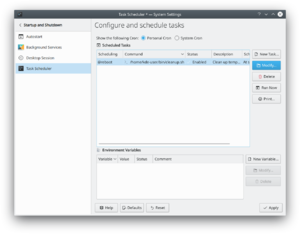System Settings/Task Scheduler/it: Difference between revisions
Appearance
Updating to match new version of source page |
Updating to match new version of source page |
||
| Line 8: | Line 8: | ||
[[Image:Kcron-screenshot-de.png|thumb|300px|center|KCron in KDE SC 4]] | [[Image:Kcron-screenshot-de.png|thumb|300px|center|KCron in KDE SC 4]] | ||
=== Utilizzo === | === Utilizzo === | ||
Task Scheduler can be started by starting the '''System Settings''' application, and selecting <menuchoice>Startup and Shutdown -> Task Scheduler</menuchoice>. | |||
New tasks can be added and existing tasks edited or removed. | |||
==== Adding and Modifying tasks ==== | |||
* Click "New Task..." to add a new task, or "Modify" to modify an existing task. The '''Add or modify existing task''' page will be displayed. | |||
[[Image:kcron-task-dialog.png|thumb|300px|center|The "Add or modify task" page of SystemSettings]] | |||
* Enter the command to be run. Click the folder icon to choose it from a dialog. | |||
* Enter a comment (optional). This should be descriptive, explaining what the task will do as the command may not always be obvious. | |||
* Click '''Enable this task''' to enable the task to run. | |||
* Click '''Run at system bootup''' to enable the script to run each time the system is booted. | |||
* Click '''Run every day''' to enable the script to run every day. This will automatically select the appropriate options. | |||
* Using the buttons, choose when the command should be run. Not all parameters are required, those not needed may be left blank. | |||
** Hours and Minutes are the time of day to run the task, not an interval. | |||
* When done, click OK. The task till be added, and scheduled if enabled. | |||
=== Suggerimenti === | === Suggerimenti === | ||
Revision as of 06:20, 25 December 2018
Informazioni generali
KCron è un'applicazione standard negli ambienti KDE. |

Utilizzo
Task Scheduler can be started by starting the System Settings application, and selecting . New tasks can be added and existing tasks edited or removed.
Adding and Modifying tasks
- Click "New Task..." to add a new task, or "Modify" to modify an existing task. The Add or modify existing task page will be displayed.

- Enter the command to be run. Click the folder icon to choose it from a dialog.
- Enter a comment (optional). This should be descriptive, explaining what the task will do as the command may not always be obvious.
- Click Enable this task to enable the task to run.
- Click Run at system bootup to enable the script to run each time the system is booted.
- Click Run every day to enable the script to run every day. This will automatically select the appropriate options.
- Using the buttons, choose when the command should be run. Not all parameters are required, those not needed may be left blank.
- Hours and Minutes are the time of day to run the task, not an interval.
- When done, click OK. The task till be added, and scheduled if enabled.
Suggerimenti
- Tutti i file che vengono modificati si trovano nella cartella /etc/cron dove ci sono numerosi file da guardare.
- Lo strumento a riga di comando che ti permette di vedere i cron-jobs attualmente definiti è
crontab -l
(l'ultima è la lettera L).
